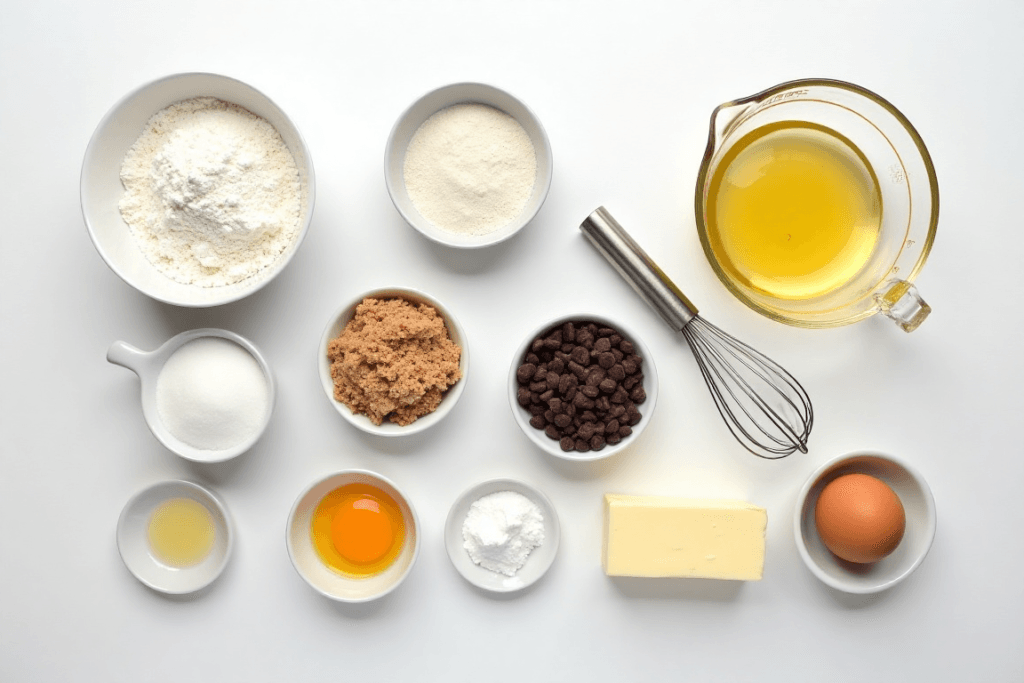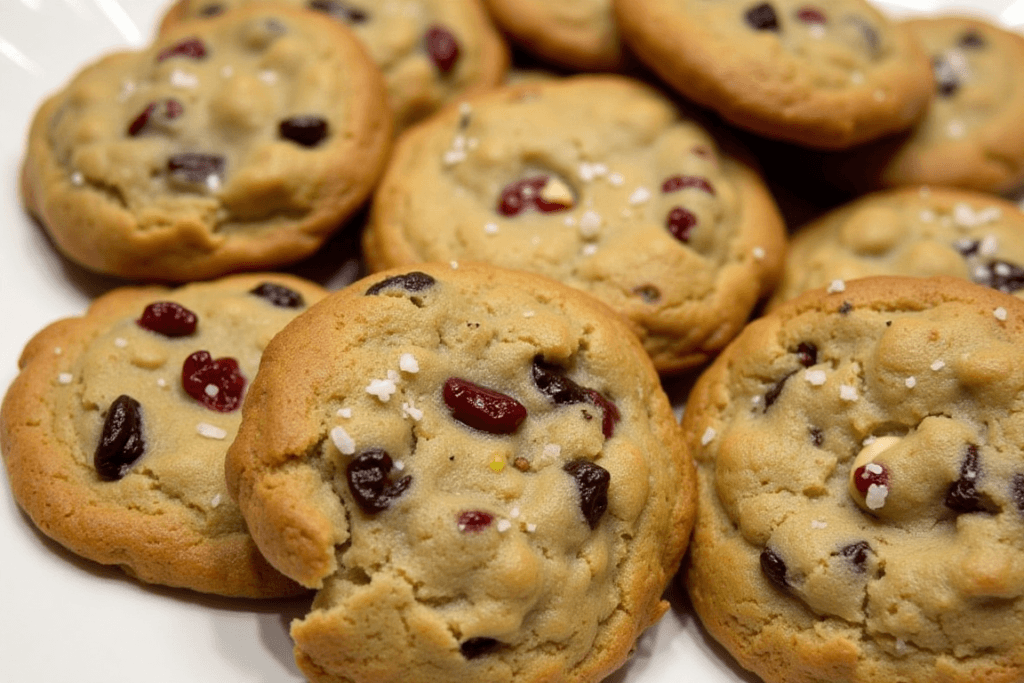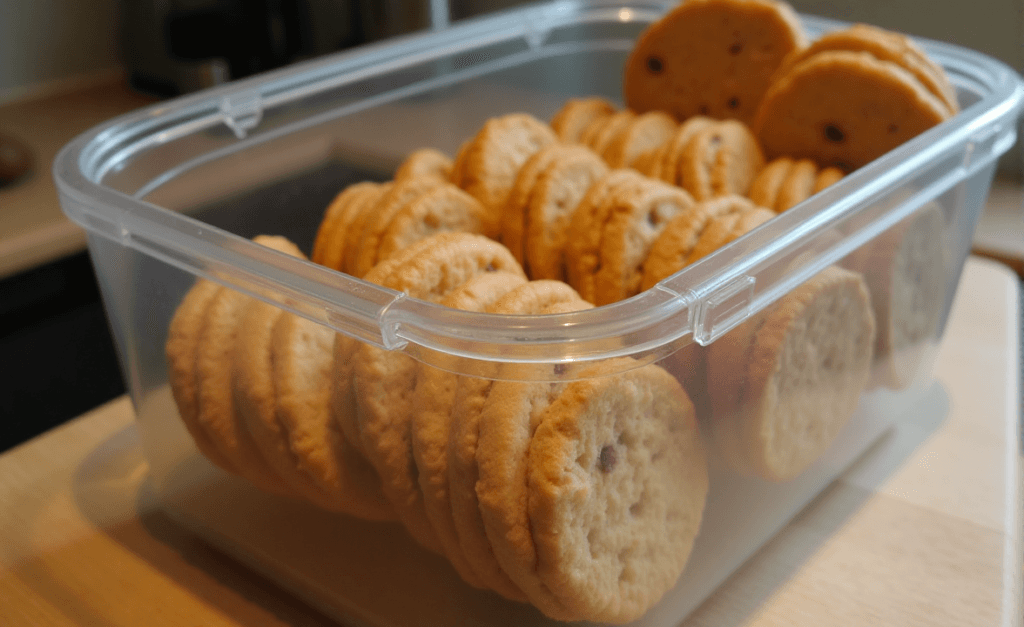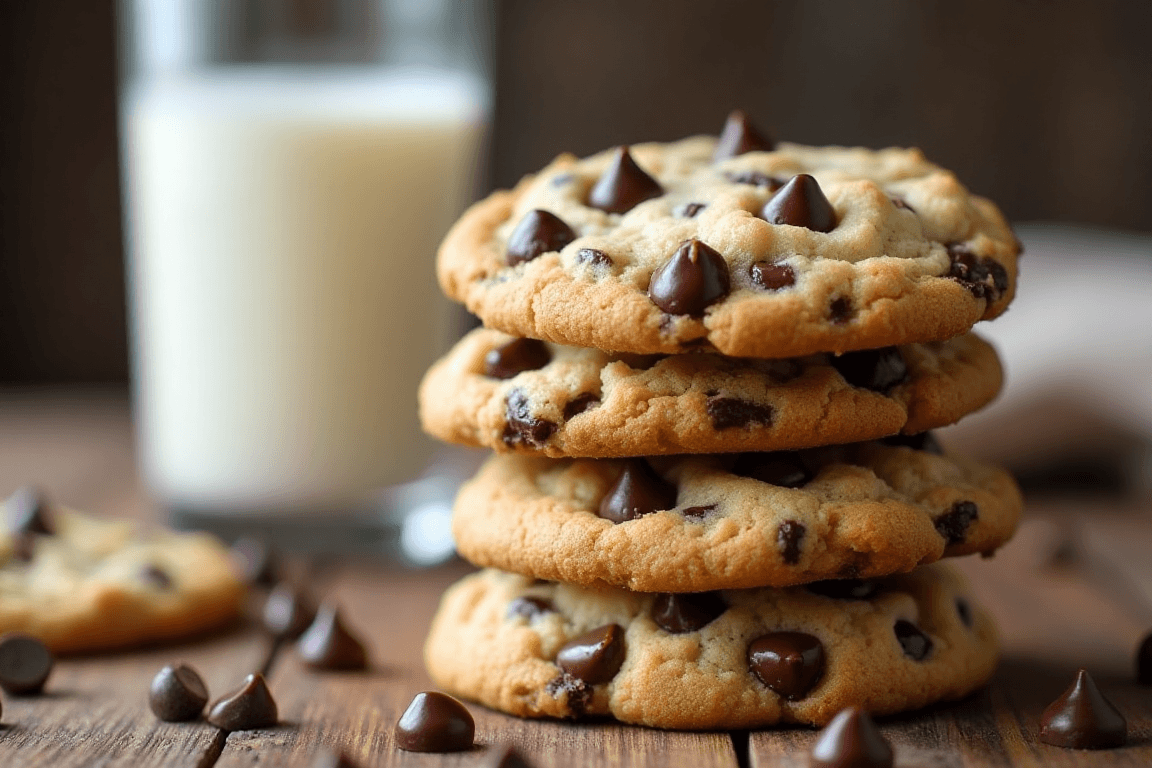Soft chocolate chip cookies are a beloved treat known for their chewy texture and rich, chocolatey flavor. Their moist, melt-in-your-mouth consistency makes them a favorite for those who enjoy a tender dessert. The secret to their softness lies in the perfect balance of ingredients like butter and brown sugar, along with careful baking techniques such as slight underbaking. Whether enjoyed warm with milk or as a snack, these cookies are a comforting delight, perfect for any occasion.
Table of Contents
Essential Ingredients for Soft Chocolate Chip Cookies
Creating soft chocolate chip cookies requires attention to the choice and quality of ingredients. Each component contributes to the cookies’ texture, flavor, and overall appeal. Here’s a closer look at three key ingredients:
Choosing the Right Type of Chocolate
The chocolate you choose plays a significant role in determining the flavor and texture of your cookies. Semi-sweet chocolate chips are the traditional choice, offering a balance of sweetness and rich cocoa flavor. For a more luxurious taste, consider using chopped chocolate bars or dark chocolate with varying cocoa percentages. The melting qualities of chocolate chunks or bars can create gooey pockets of chocolate, enhancing the soft texture of the cookie. For added variety, you can experiment with milk chocolate, white chocolate, or even flavored chips like caramel or mint.
Importance of Brown Sugar

Brown sugar is a cornerstone ingredient for soft chocolate chip cookies. Its high moisture content and molasses content help create a chewy, tender texture. Compared to granulated sugar, brown sugar also imparts a rich, caramel-like flavor that enhances the overall taste of the cookie. Using a higher proportion of brown sugar to white sugar ensures the cookies remain moist and flavorful over time.
Role of Butter and Its Texture
Butter is critical in achieving the desired softness and richness in chocolate chip cookies. The texture of the butter whether softened, melted, or browned affects the final outcome. Softened butter allows for better creaming with sugar, creating a lighter, fluffier dough that bakes into softer cookies. Melted butter, on the other hand, often results in denser cookies but retains softness due to the added moisture. Using unsalted butter lets you control the salt content, while browning the butter can introduce a nutty, toasty flavor that elevates the cookie’s complexity.
By carefully selecting and preparing these essential ingredients, you set the foundation for irresistibly soft chocolate chip cookies that are sure to delight every time.
Tools You’ll Need for Making Soft Chocolate Chip Cookies
Having the right tools can make the process of baking soft chocolate chip cookies more efficient and enjoyable. Here are two essential tools and considerations for preparing these classic treats:
Baking Sheets and Parchment Paper
A good-quality baking sheet is crucial for evenly baked cookies. Opt for heavy-duty, light-colored baking sheets, as dark sheets can absorb more heat and cause the cookies to brown too quickly on the bottom. Lining the baking sheets with parchment paper offers several benefits: it prevents sticking, ensures even baking, and makes cleanup a breeze. If parchment paper isn’t available, a silicone baking mat can serve as a reusable alternative with similar results.
Electric Mixer vs. Manual Mixing
The method you choose for mixing the cookie dough can affect the texture and consistency of your cookies.
- Electric Mixer: Using a stand or hand mixer speeds up the process and ensures thorough mixing of the butter, sugar, and eggs, creating a fluffy base for your cookies. An electric mixer is especially useful when creaming softened butter with sugar, as this step requires effort to achieve the light, airy texture that contributes to soft cookies.
- Manual Mixing: If you prefer a more hands-on approach or don’t have an electric mixer, a sturdy whisk or wooden spoon can do the job. This method allows you to control the mixing process more carefully, which is useful for avoiding overmixing. However, it may require more time and effort, particularly for creaming butter and sugar.
Each tool and method has its advantages, so choose based on your preferences and what you have available. Whether you use an electric mixer or mix by hand, the right tools will help you achieve soft, delicious cookies with ease.
If you’re curious about ingredient alternatives, you can find ideas in this article on substitute for baking soda, which explores creative swaps for common baking ingredients.
Preparing the Dough for Soft Chocolate Chip Cookies
Proper preparation of the dough is essential for achieving soft and delicious chocolate chip cookies. Follow this step-by-step guide and tips to ensure your dough is mixed perfectly.
Step-by-Step Guide to Mixing Ingredients
- Gather and Measure Ingredients:
Begin by measuring all your ingredients accurately. Use measuring cups and spoons for dry ingredients and a kitchen scale for precision, if available. - Cream, Butter, and Sugars:
In a large mixing bowl, combine softened butter, brown sugar, and granulated sugar. Use an electric mixer or a sturdy whisk to cream them together until the mixture is light and fluffy. This step creates air pockets in the dough, contributing to a soft texture. - Add Wet Ingredients:
Mix in the eggs one at a time, ensuring each is fully incorporated. Then add vanilla extract, which enhances the flavor of the cookies. - Combine dry ingredients separately:
In another bowl, whisk together the flour, baking soda, and salt. This ensures the leavening agent is evenly distributed and prevents clumping. - Incorporate dry into wet ingredients:
Gradually add the dry ingredients to the wet mixture, mixing on low speed (or gently by hand) to avoid a flour cloud. Stop mixing as soon as you see the dough coming together. - Add Chocolate Chips:
Fold in the chocolate chips using a spatula or wooden spoon. Be gentle to avoid overworking the dough. - Chill the Dough (Optional):
For thicker, chewier cookies, cover the dough and chill it in the refrigerator for 30 minutes to an hour before baking. Chilling helps the dough firm up and enhances the flavors.
How to Avoid Overmixing
Overmixing can lead to dense, tough cookies. Here’s how to prevent it:
- Stop Mixing Early: Mix the dough just until no streaks of flour remain. Once the ingredients are combined, overmixing will develop the gluten in the flour, leading to a less tender texture.
- Use a Gentle Hand: If mixing by hand, stir gently to incorporate ingredients without overworking the dough.
- Monitor Dough Texture: The dough should be soft and slightly sticky but hold its shape. If it feels overly elastic, you may have mixed too much.
By following these steps and being mindful of mixing, you’ll create a perfectly prepared dough that bakes into soft and delectable chocolate chip cookies.
Tips for Keeping Cookies Soft
Ensuring your chocolate chip cookies remain soft and tender requires a combination of the right ingredients and proper techniques. Here are two important factors to consider:
Role of Cornstarch in Cookies
Cornstarch is a secret weapon for creating soft, melt-in-your-mouth cookies. Adding a small amount of cornstarch to your cookie dough helps in the following ways:
- Tender Texture: Cornstarch acts as a tenderizer by softening the protein structure in the flour, resulting in cookies that are delicate and chewy.
- Preventing Spread: It helps cookies hold their shape while baking, reducing excessive spreading. This contributes to a thicker, softer cookie with a better texture.
- Smoothness: It adds a velvety quality to the dough, enhancing the overall softness of the finished product.
Typically, 1–2 teaspoons of cornstarch are added to the dry ingredients for a standard cookie recipe. This small addition can make a big difference in the texture of your cookies.
Chilling the Dough: Pros and Cons
Pros:
- Enhanced Flavor: Chilling allows the flavors in the dough to meld and deepen, resulting in richer, more complex cookies.
- Improved Texture: Chilling firms up the dough, which prevents the cookies from spreading too much during baking. This leads to a thicker, chewier cookie.
- Easier Handling: Cold dough is less sticky and easier to portion, making it more manageable to shape into uniform balls or scoops.
Cons:
- Takes More Time: Chilling the dough requires patience, as it adds 30 minutes to several hours to the baking process.
- Dense Cookies (If Over-Chilled): Over-chilling can make the dough too firm, resulting in cookies that don’t spread enough and may bake unevenly.
- Potential for Overworking: If the chilled dough is too hard, excessive handling during scooping or shaping can lead to overmixing, affecting the final texture.
How to Maximize Benefits
Chill the dough for 30 minutes to an hour for best results. If you refrigerate it longer (e.g., overnight), let the dough sit at room temperature for a few minutes before scooping to ensure it’s pliable but still cool.
By understanding the role of cornstarch and the advantages and disadvantages of chilling, you can master the art of creating soft and perfectly textured chocolate chip cookies every time.
Baking Soft Chocolate Chip Cookies to Perfection
The baking process is crucial for achieving perfectly soft chocolate chip cookies. Proper temperature, timing, and techniques ensure your cookies turn out tender, chewy, and irresistibly delicious.
Ideal Oven Temperature and Timing
- Oven Temperature:
The ideal temperature for baking soft chocolate chip cookies is 350°F (175°C). This moderate heat allows the cookies to bake evenly, ensuring the center remains soft while the edges turn slightly golden. - Baking Time:
Typically, cookies bake for 8 to 12 minutes, depending on their size. For soft cookies, aim for the shorter end of this range. Remember, the cookies will continue to bake slightly on the hot baking sheet even after being removed from the oven. - Uniformity:
To ensure even baking, use a cookie scoop to portion out the dough evenly and space cookies at least 2 inches apart on the baking sheet. For consistent results, bake one sheet at a time in the center of the oven.
Checking Doneness Without Overbaking
Overbaking is one of the most common reasons cookies lose their softness. Here’s how to ensure they are perfectly baked:
- Visual Cues:
- Look for edges that are just starting to turn golden brown while the centers still appear slightly underdone or glossy.
- The cookies should appear puffed up in the center but will settle as they cool.
- Touch Test:
Gently press the center of a cookie with your fingertip or the back of a spoon. It should feel soft but not raw. Avoid pressing too hard, as the cookies are fragile while hot. - Timer Discipline:
Set a timer and check the cookies at the lower end of the recommended baking time. Even a minute too long in the oven can lead to firmer cookies. - Residual Heat:
Remove the cookies from the oven just before they are fully baked, as residual heat from the baking sheet will finish cooking them. Allow them to cool on the sheet for 2–3 minutes before transferring to a wire rack.
By maintaining the correct oven temperature, carefully monitoring baking time, and checking doneness properly, you can ensure your cookies remain soft, chewy, and utterly delightful every time.
Variations of the Recipe for Soft Chocolate Chip Cookies

Soft chocolate chip cookies are incredibly versatile, allowing you to experiment with different flavors and ingredients to suit various preferences and dietary needs. Here are some popular variations to try:
Adding Nuts or Other Flavors
- Nuts:
Enhance the texture and flavor of your cookies by adding chopped nuts. Common choices include:- Walnuts for a mild, buttery crunch.
- Pecans for a rich, sweet flavor.
- Almonds for a light, nutty taste and crunch.
- Other Flavor Additions:
Experiment with these ingredients to create unique variations:- Dried Fruits: Add dried cranberries, raisins, or cherries for a chewy, fruity twist.
- Spices: Mix in a pinch of cinnamon, nutmeg, or cardamom for warmth and complexity.
- Extracts: Substitute or supplement vanilla extract with almond, coconut, or mint extract for a distinctive flavor profile.
- Specialty Ingredients:
For a gourmet touch, consider adding:- Toffee bits for a caramel crunch.
- Sea salt flakes sprinkled on top for a sweet-and-salty contrast.
- Shredded coconut for a tropical flair.
For more baking inspiration, check out this guide to making the perfect Nestle cookie recipe, which provides tips for soft and chewy results.
Alternative Flours for Dietary Preferences
For those with specific dietary needs, substitute traditional all-purpose flour with these alternatives:
- Gluten-Free Flour:
Use a high-quality, cup-for-cup gluten-free flour blend designed for baking. These blends often include xanthan gum or guar gum to mimic the elasticity of gluten. - Almond Flour:
A great low-carb, gluten-free option that gives cookies a rich, nutty flavor. Replace up to 50% of the all-purpose flour to maintain structure, or use almond flour exclusively in recipes designed for it. - Oat Flour:
Made from finely ground oats, oat flour adds a mild sweetness and chewy texture. Use in combination with all-purpose flour or a gluten-free blend. - Coconut Flour:
High in fiber and gluten-free, coconut flour absorbs more liquid than regular flour. Use sparingly (about ¼ cup for every 1 cup of all-purpose flour) and increase the eggs and liquid in your recipe. - Whole Wheat Flour:
For a heartier texture and added nutrients, substitute half of the all-purpose flour with whole wheat flour. This will result in slightly denser cookies but still maintain their softness.
By incorporating nuts, flavors, or alternative flours, you can create customized versions of soft chocolate chip cookies that cater to diverse tastes and dietary requirements.
Storing Your Cookies
Proper storage ensures your soft chocolate chip cookies remain fresh and delicious for as long as possible. Whether you plan to enjoy them soon or save them for later, here’s how to store them effectively:
Best Ways to Keep Cookies Fresh

- Use an Airtight Container:
Place cookies in an airtight container to prevent them from drying out. If stacking cookies, separate layers with parchment paper to keep them from sticking together. - Add Moisture Retainers:
To maintain softness, include a slice of bread or a marshmallow in the container. These items help retain moisture, keeping the cookies tender. - Store at Room Temperature:
Soft cookies can be stored at room temperature for up to 5 days. Avoid refrigeration, as this can dry them out and alter their texture. - Keep Away from Heat and Sunlight:
Store the container in a cool, dry place to avoid exposure to heat, which can cause the cookies to lose their softness.
Freezing Cookies for Future Enjoyment
Freezing is a fantastic way to extend the shelf life of your cookies or save unbaked dough for later. Here’s how to do it:
Freezing Baked Cookies:
- Cool Completely:
Allow cookies to cool completely before freezing to prevent condensation. - Wrap Individually:
Wrap each cookie in plastic wrap or aluminum foil to protect against freezer burn. - Use Freezer Bags or Containers:
Place wrapped cookies in a resealable freezer bag or an airtight container, removing as much air as possible. Label with the date. - Freeze for Up to 3 Months:
Cookies remain fresh in the freezer for up to 3 months. To enjoy, thaw them at room temperature or warm them in a low oven (300°F/150°C) for a few minutes.
Freezing Cookie Dough:
- Scoop and Pre-Freeze:
Portion the dough into balls using a cookie scoop, then place them on a baking sheet lined with parchment paper. Freeze until firm (about 1–2 hours). - Transfer to Freezer Bags:
Place the frozen dough balls in a resealable freezer bag or container. Label with the date and baking instructions. - Bake from Frozen:
When ready to bake, place the frozen dough balls directly on a baking sheet. Add an extra 2–3 minutes to the baking time, and they’ll come out as fresh as newly made.
By storing cookies properly or freezing them for future enjoyment, you can ensure your soft chocolate chip cookies are always ready to satisfy a sweet craving.
Learn tips for freezing baked goods from this resource on ultimate ninja creami recipes, which also covers freezing techniques.
FAQs About Soft Chocolate Chip Cookie Recipe
What is the secret to making soft cookies?
The secret to making soft cookies lies in the combination of ingredients and baking techniques:
- Brown Sugar: Using more brown sugar than granulated sugar helps retain moisture, making cookies softer.
- Butter Texture: Softened butter, when creamed with sugar, creates air pockets that contribute to softness.
- Baking Time: Slightly underbaking the cookies ensures they remain soft even after cooling.
- Chilling Dough: Chilling the dough prevents excessive spreading and helps achieve a soft, chewy center.
What makes a cookie chewy and soft?
Several factors contribute to chewy and soft cookies:
- High Moisture Content: Ingredients like brown sugar, eggs, and even cornstarch retain moisture.
- Proper Fat Ratio: A higher fat content, such as butter or a mix of butter and shortening, enhances chewiness.
- Minimal Mixing: Avoid overmixing the dough to prevent gluten development, which can make cookies tough.
- Thick Dough: Chilling the dough or slightly increasing the flour content creates thicker cookies, which are chewier and softer.
What makes a cookie light and fluffy?
Light and fluffy cookies depend on incorporating air into the dough and using the right ingredients:
- Creaming Butter and Sugar: Beating softened butter and sugar until light and fluffy introduces air pockets, which expand during baking.
- Leavening Agents: Baking soda and baking powder help cookies rise and become airy.
- Room Temperature Ingredients: Eggs and butter at room temperature mix more evenly, resulting in a consistent texture.
- Proper Mixing Technique: Mix just enough to combine ingredients without deflating the batter.
Are chocolate chip cookies better with melted or softened butter?
The choice between melted and softened butter depends on the desired texture:
- Softened Butter: Produces cookies with a light, fluffy texture and slightly crisp edges. It’s ideal for traditional soft chocolate chip cookies.
- Melted Butter: Creates denser, chewier cookies. The liquid state of melted butter increases moisture content, which leads to a softer center but less aeration during mixing.
Recommendation: For soft and chewy cookies, softened butter is usually the better choice, but melted butter can be used for a richer, chewier variation.
By understanding these key factors, you can tailor your recipe to achieve the exact texture and softness you prefer in your chocolate chip cookies.

Soft Chocolate Chip Cookies
Equipment
- Mixing Bowls: One medium (for dry ingredients) and one large (for wet ingredients)
- Electric Mixer or Hand Whisk: For creaming and mixing
- Measuring Cups & Spoons: For accuracy
- Baking Sheet: To bake the cookies
- Parchment Paper: For lining the baking sheet
- Cooling Rack: To cool the cookies evenly
- Spatula or Wooden Spoon: For folding and stirring
Ingredients
- Dry Ingredients:
- 2 1/4 cups all-purpose flour
- 1/2 teaspoon baking soda
- 1/2 teaspoon salt
- Wet Ingredients:
- 3/4 cup unsalted butter melted (or softened butter for extra creaminess)
- 1 cup packed brown sugar
- 1/2 cup granulated sugar
- 1 tablespoon vanilla extract
- 1 large egg plus 1 extra egg yolk for added richness
- Add-ins:
- 2 cups semisweet chocolate chips
- Optional: 1 cup chopped walnuts or pecans
Instructions
- Preheat & Prepare:
- Preheat your oven to 325°F (165°C). Line a baking sheet with parchment paper.
- Mix Dry Ingredients:
- In a medium bowl, whisk together the flour, baking soda, and salt. Set aside.
- Cream Butter & Sugars:
- In a large bowl, combine the melted (or softened) butter with the brown sugar and granulated sugar. Beat until smooth and well blended.
- Incorporate Eggs & Vanilla:
- Mix in the vanilla extract, egg, and extra egg yolk until the mixture becomes light and creamy.
- Combine Mixtures:
- Gradually add the dry ingredients to the wet mixture. Stir until just combined; avoid overmixing to keep the cookies tender.
- Fold in Chocolate Chips:
- Gently fold in the chocolate chips (and nuts, if using).
- Portion the Dough:
- Drop tablespoon-sized balls of dough onto the prepared baking sheet, spacing them about 2 inches apart.
- Bake:
- Bake for 12–14 minutes, or until the edges are set and just beginning to turn golden. The centers should still look soft.
- Cool:
- Remove the cookies from the oven and let them cool on the baking sheet for about 5 minutes before transferring them to a cooling rack to cool completely.
- Enjoy:
- Serve warm or at room temperature for a delectably soft and chewy treat!
- Details
- Prep Time: 15 minutes
- Cook Time: 12–14 minutes per batch
- Time Total: Approximately 30 minutes (including cooling time)
- Yield: About 24 cookies
- Category: Dessert
- Method: Baking
- Cuisine: American
- Diet: Vegetarian (contains dairy and eggs)
- Keywords
- soft cookies, chocolate chip cookies, chewy cookies, homemade cookies, dessert, baked goods, sweet treat, classic recipe
- Nutrition (per cookie, approximate)
- Serving Size: 1 cookie (≈30g)
- Calories: 150 kcal
- Sugar: 10 g
- Sodium: 80 mg
- Total Fat: 8 g
- Saturated Fat: 5 g
- Unsaturated Fat: 2 g
- Trans Fat: 0 g
- Carbohydrates: 20 g
- Fiber: 1 g
- Protein: 2 g
- Cholesterol: 20 mg
- Note: Nutritional values are approximate and can vary based on ingredient brands and measurements.
Notes
Watch the Oven: Baking times can vary by oven; keep an eye on your cookies so they remain soft and chewy.
Storage: Store cookies in an airtight container at room temperature for up to 5 days. For longer storage, freeze them and reheat gently before serving.
Customization: Feel free to mix in nuts or substitute some of the semisweet chips with milk or dark chocolate chips to suit your taste.
Extra Richness: The addition of an extra egg yolk contributes to a richer, softer texture—perfect for those who love melt-in-your-mouth cookies.
